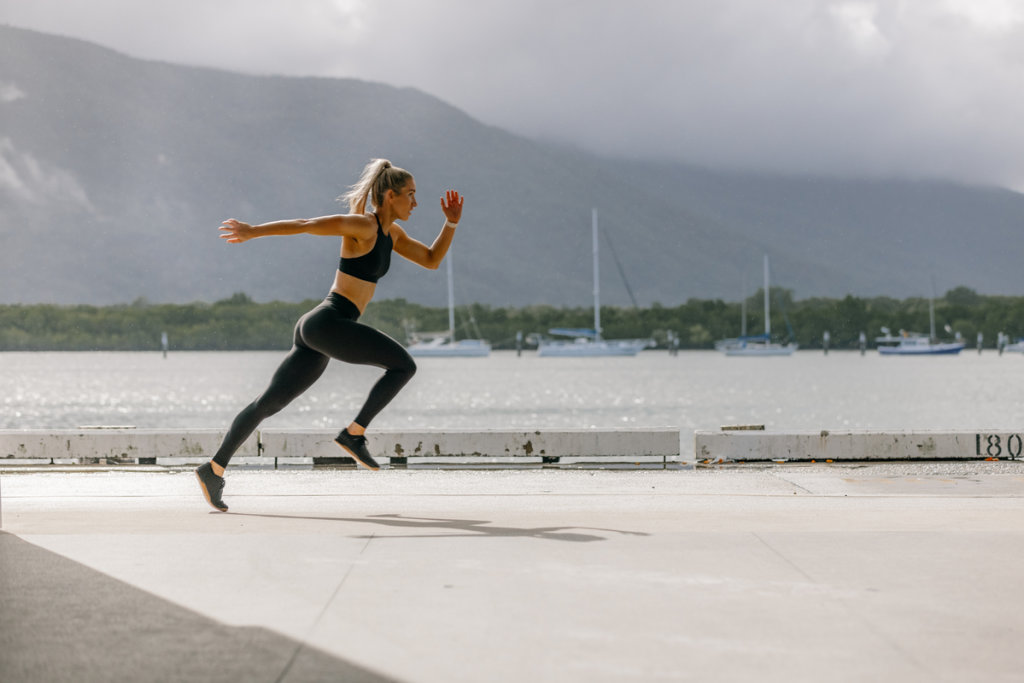How To Get Fit: The 5 Components Of Fitness

September 6, 2022

So you want to get fit? Amazing, you’ve come to the right place!
Deciding to improve your fitness is the start of a very empowering and rewarding health journey, but there’s no doubt it can be challenging, too! It’s normal to have some questions about what it truly means to be fit and what you should be including in your weekly routine to ensure you’re making progress.
When people hear the word fitness, they often think of how easily a person can run 10km or complete a bunch of burpees, but holistic fitness is about so much more than our go-to physical activity. It can help to think of fitness as an umbrella term, with five main components:
Cardiovascular endurance
Muscular strength
Muscular endurance
Flexibility
Body composition
A well-balanced workout routine will factor in all five of these components and give some love to each of them so you can reap the maximum health benefits! So what does each component mean and what sort of activity should you be doing to improve it? Let’s break it down.
Cardiovascular endurance
Also known as aerobic fitness, this refers to how efficiently and effectively your body can take in oxygen and deliver it to your body’s tissues through your cardiovascular system - that’s your heart, lungs and blood vessels.
Boosting your cardiovascular endurance means doing any form of exercise that works your cardiovascular system for an extended period of time. This is any kind of cardio activity that gets you puffing - think brisk walking, running, cycling, swimming, jump rope, boxing, circuit training and dancing, to name a few!
Mayo Clinic recommends you get at least 150 minutes of moderate aerobic activity or 75 minutes of vigorous aerobic activity each week, or enjoy a combination of the two. An easy way to tell the difference is by using the talk test. If you can talk, you’re exercising at a moderate intensity. If talking is difficult, you’re exercising at a vigorous intensity.
Not only does this type of exercise work to keep your heart, lungs and circulatory system healthy, it can also make many of your daily activities much easier, whether that’s a HIIT workout, playing with your kids, going for a walk with a friend, running to catch the bus or dancing at a concert.

Muscular strength
This refers to the strength and power your muscles have that allows you to lift heavy objects. The more muscular strength you have, the more weight you can lift.
Building your muscular strength isn’t just about being able to lift heavy weights or flex big biceps, it’s also important for your bone health, posture, balance and stability. Working on your strength can help you to lift things like weights, groceries, luggage, furniture and even your kids with greater ease and a reduced risk of injury.
Mayo Clinic recommends performing strength training exercises for all major muscle groups at least twice a week. This could either be lifting light to moderate weights for sets of 12-15 reps, or lifting a heavy, challenging weight for sets of 4-8 reps. Both are effective ways to fatigue your muscles and improve your strength.
When your workouts start to feel easier, you can challenge your body to see improvements by implementing progressive overload, where you gradually increase the weight, volume (e.g. reps), training frequency or intensity. You can also test your one rep max (1RM) occasionally for different movements such as bench press, squat and deadlift to see your strength progress. Sweat programs BUILD and Lifting At Home use both of these techniques, and other programs such as PWR or High Intensity Strength with Kayla will also help increase your strength!
Muscular endurance
This is about the ability of your muscles to continuously contract for extended periods of time, rather than just a few seconds for a heavy lift.
Running, cycling, hiking and circuit training are all effective ways to test your muscular endurance, as are isometric movements that you hold for long periods, such as holding a plank or a squat. It’s an important component of fitness because it allows you to continuously move without your body getting tired.
To improve your muscular endurance, it can help to include circuit training or high rep strength training using low to moderate weights in your routine.

Flexibility
This is such an important part of fitness, but it’s something that often slips down our list of priorities when life gets busy! Flexibility refers to the ease at which your muscles and joints can move through a full range of motion without pain or stiffness.
When you don’t work on your flexibility, your muscles and joints can become stiff and movements can become limited, uncomfortable or even painful. According to Harvard Health, being flexible can help to prevent injuries and pain while also having a positive effect on your balance and overall athletic performance.
There are a few things you can do each week to improve your flexibility. As part of your warm-up, you can perform some dynamic stretches to prepare your body for the movements to come in your workout. Static stretches (holding a stretch for 10-30 seconds) should be part of your cool-down or a dedicated recovery session, and if you’re looking for a training style that incorporates flexibility training, you could try Pilates, barre or yoga!
One quick and simple flexibility test is to sit or stand and lean forward to try and touch your toes. This tests the flexibility in your back, glutes, ankles, and hamstrings. As you practice different stretches, you might notice certain areas need a little more TLC than others.
Muscles feeling tight? Try some of these:
Body composition
This final component refers to your body’s ratio of fat mass to fat-free mass, such as muscle and bone. Having some body fat is essential tissue for optimal health (including warmth and hormone health), but having too much, particularly visceral fat which is stored around your stomach and organs, has been linked to a greater risk of diseases and health conditions such as heart disease, type 2 diabetes, respiratory and joint problems, and cancer.
Decreasing your fat mass and increasing your bone and muscle mass can improve your health and reduce your risk of chronic diseases. The great news? Improving your body composition is often a natural result of leading a healthy lifestyle and taking care of the other four components with a mix of cardio, strength and flexibility training.
Measuring your body composition isn’t something you can do on a standard set of scales or by calculating your BMI (body mass index). You either need to use a special set of scales or undergo a body composition test overseen by a professional.
Understanding these five components of fitness can help you to structure your workout routine for maximum health benefits or to understand why your Sweat program is structured the way it is (and why the Sweat Trainers strongly encourage you to complete your recovery sessions!).
If you naturally enjoy some of these components more than others, that’s totally normal, but it doesn’t mean you should neglect the parts you don’t love. It can help to find a way to easily incorporate those things into the parts of your schedule you do enjoy. If you tend to neglect stretching, try getting in the habit of finishing each workout with a quick five-minute stretch, or if strength training isn’t your thing, an Express Workout could be exactly what you need.
Making fitness an enjoyable part of your life that you look forward to is key for your long-term health, so work on these five components to help improve your fitness in a way that works best for YOU.

A more empowered you starts with Sweat, and our editorial team is here to bring you the latest fitness tips, trainer recommendations, wellbeing news, nutritional advice, nourishing recipes and free workouts.
* Disclaimer: This blog post is not intended to replace the advice of a medical professional. The above information should not be used to diagnose, treat, or prevent any disease or medical condition. Please consult your doctor before making any changes to your diet, sleep methods, daily activity, or fitness routine. Sweat assumes no responsibility for any personal injury or damage sustained by any recommendations, opinions, or advice given in this article.
Fitness